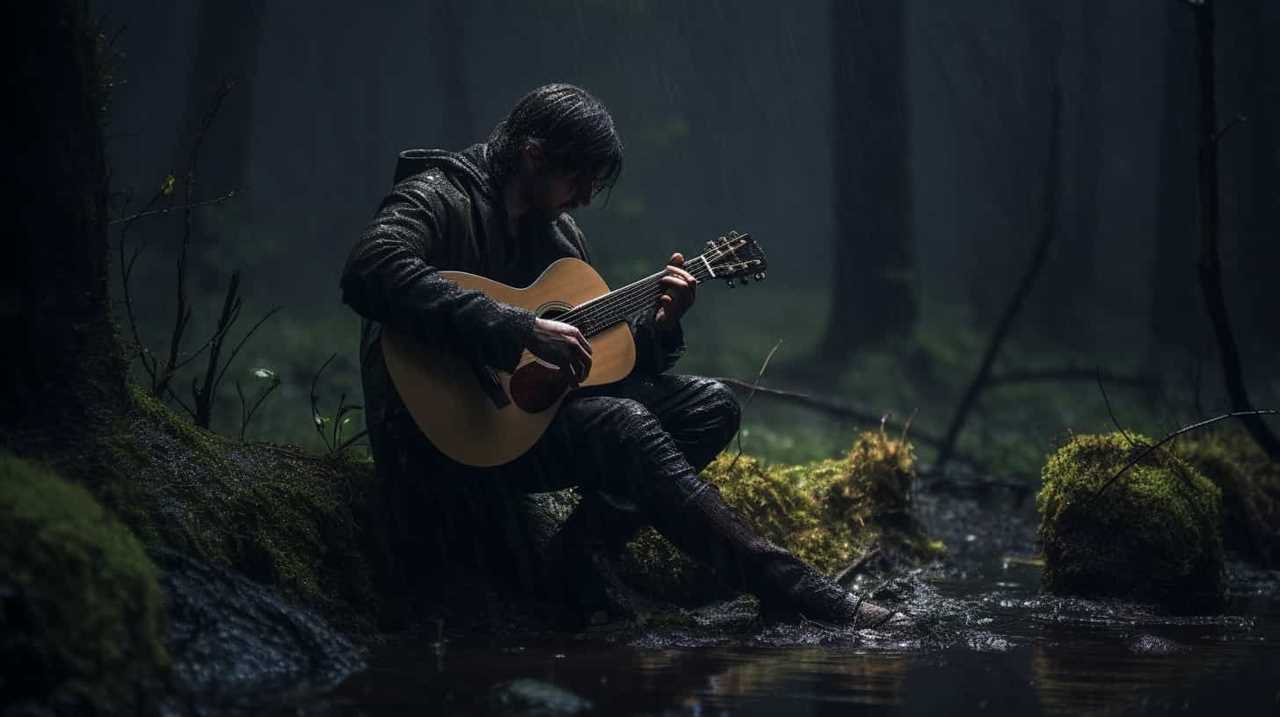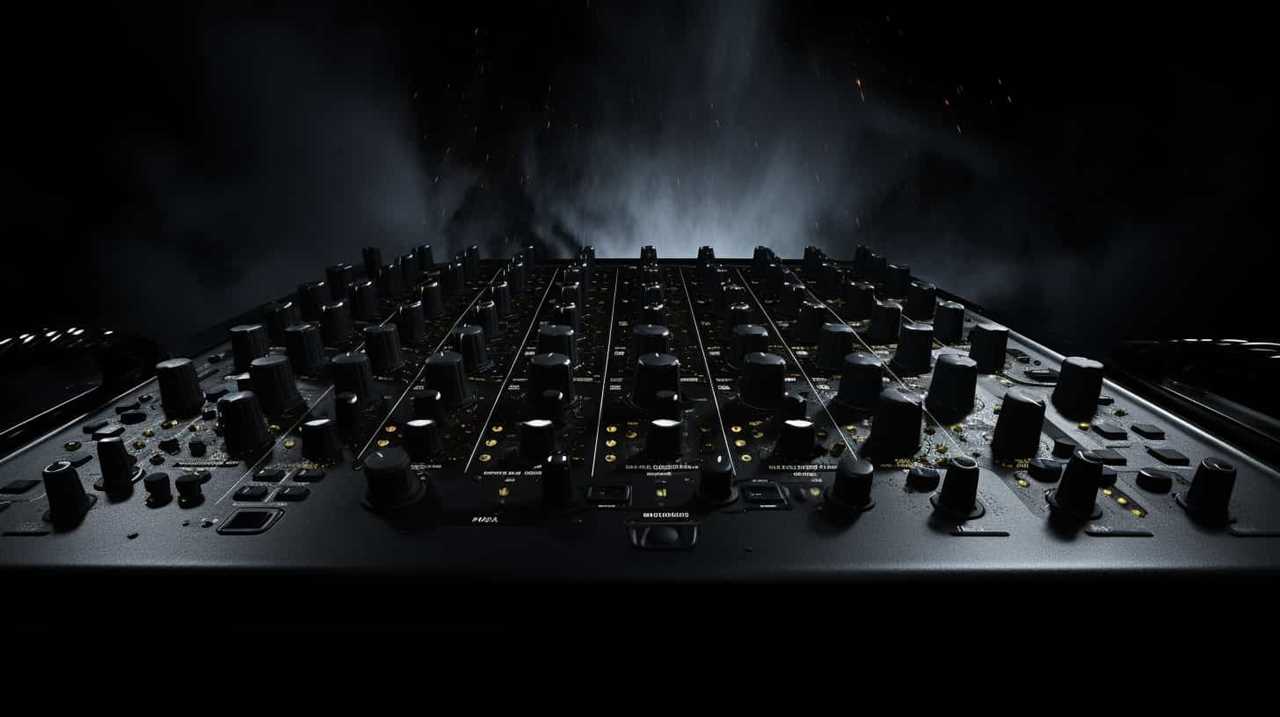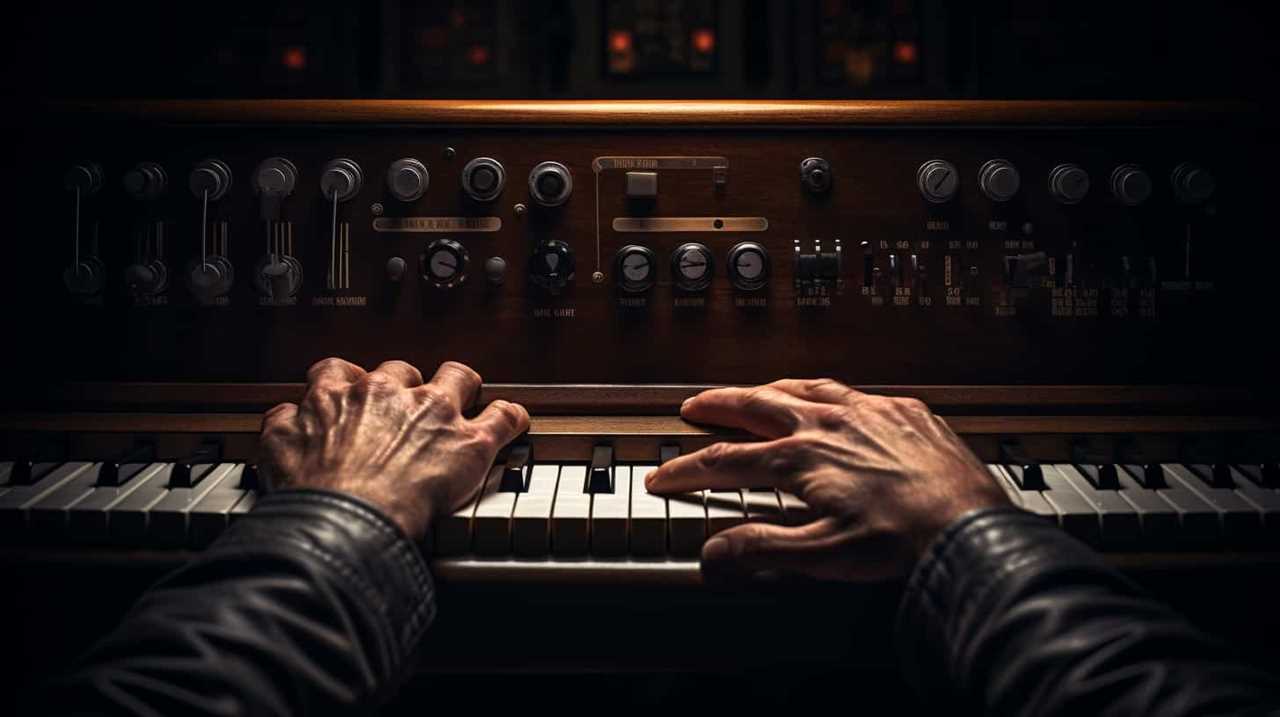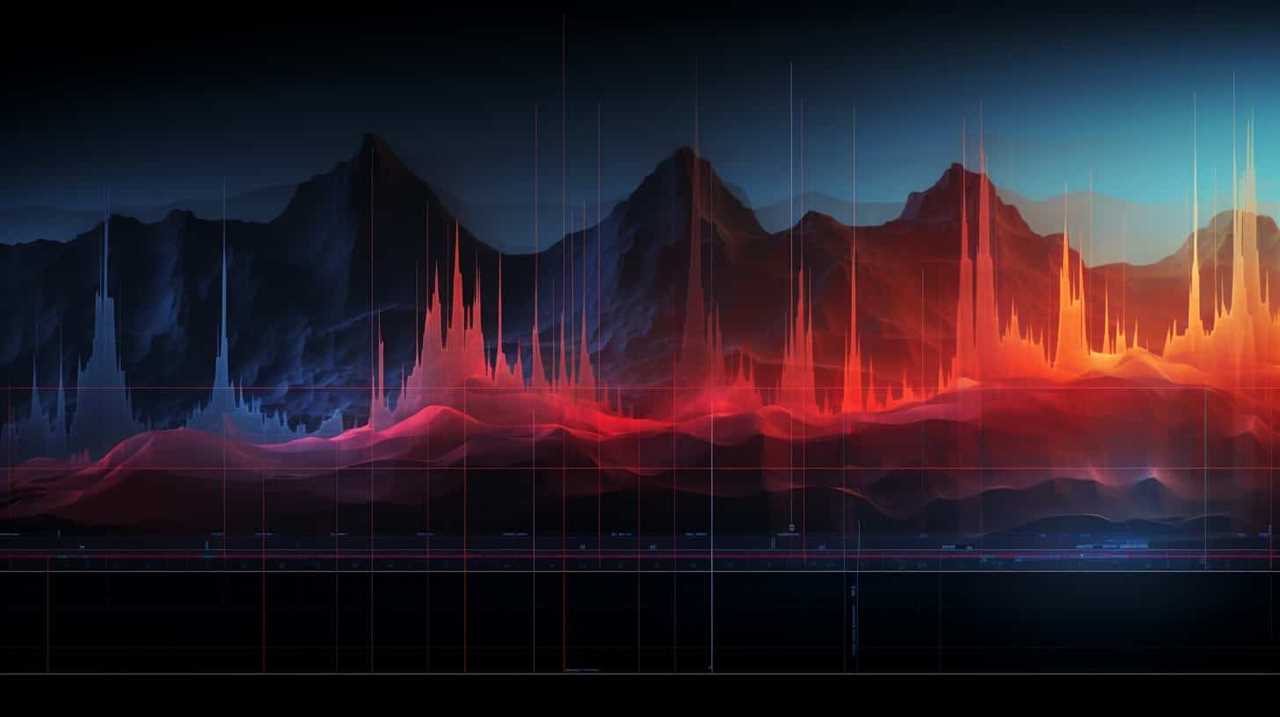Get ready to delve into the mysterious world of creating dark ambient music.
In this article, we unveil seven intriguing techniques that will take your compositions to haunting new heights.
From crafting ethereal pads with ambient reverb to manipulating soundscapes with granular synthesis, we explore unconventional methods that will ignite your creativity.
Join us as we uncover the secrets behind creating mesmerizing atmospheres and delve into the depths of innovation.

Prepare to be captivated by the dark and otherworldly sounds that await you.
Key Takeaways
- Incorporating field recordings and manipulating nature can capture eerie sounds in dark ambient music.
- Granular synthesis allows for precise control over sound manipulation and the creation of unique sonic textures.
- Experimental sound manipulation techniques push the boundaries of traditional musicality and add depth and complexity to dark ambient music.
- Foley effects, unconventional instruments, and unusual soundscapes enhance the dark and unsettling atmosphere of dark ambient compositions.
Creating Haunting Atmospheres With Field Recordings
One of the most effective ways we can create haunting atmospheres in our dark ambient music is by incorporating field recordings. By manipulating nature and capturing eerie sounds, we can transport our listeners to otherworldly realms. Field recordings offer a unique opportunity to harness the raw power of the natural world and infuse it into our music.
From the rustling of leaves in a desolate forest to the distant echoes of a howling wind, these sounds can evoke a sense of unease and mystery. By carefully selecting and manipulating these recordings, we can create a sonic landscape that’s both unsettling and captivating.
The juxtaposition of these natural sounds with electronic elements adds a layer of complexity and innovation to our compositions. Field recordings allow us to tap into the primal fear that resides within us all, making them an essential tool for any dark ambient musician seeking to push the boundaries of their art.

Manipulating Soundscapes With Granular Synthesis
Granular synthesis is a fundamental technique for manipulating soundscapes in dark ambient music production.
By breaking down audio samples into tiny grains and rearranging them in various ways, unique sonic textures are created, adding an experimental and immersive quality to the music.
This technique allows for precise control over the sound, enabling the producer to explore new and intriguing avenues of sound manipulation within the dark ambient genre.
Granular Synthesis Basics
We can enhance our dark ambient music productions by delving into the basics of granular synthesis and exploring how to manipulate soundscapes using this powerful technique. Granular synthesis is a method of sound synthesis that involves breaking down audio into tiny grains and manipulating them individually.

Here are five techniques that can be used to manipulate soundscapes using granular synthesis:
- Time stretching: Stretching or compressing the duration of grains to create slow, atmospheric textures or fast, glitchy effects.
- Pitch shifting: Altering the pitch of individual grains to create harmonies or dissonance.
- Grain density: Adjusting the number of grains per unit of time to control the density of the sound.
- Grain position: Shifting the position of grains within the sound field to create spatial effects.
- Grain size: Changing the size of grains to control the timbre and texture of the sound.
Unique Sonic Textures
Exploring different techniques and experimenting with various settings can lead to creating unique sonic textures while manipulating soundscapes with granular synthesis. By delving into the world of granular synthesis, we can uncover new ways to manipulate audio and create atmospheric tension within our compositions. One technique that can be employed is the manipulation of grain size and density. Adjusting these parameters allows us to explore sonic landscapes that range from dense and intense to sparse and ethereal. Another technique involves altering the grain envelope, which controls the attack, sustain, and decay of each grain. By modifying these settings, we can shape the overall texture and create dynamic shifts in our soundscapes. Additionally, exploring different modulation sources and targets can further enhance the sonic textures, adding movement and complexity to the composition. By harnessing the power of granular synthesis, we can unlock a world of possibilities for creating unique and captivating sonic experiences.
| Technique | Description | Example |
|---|---|---|
| Grain Size and Density | Adjusting the size and density of grains in granular synthesis. | Creating a dense and intense auditory experience by increasing grain density. |
| Grain Envelope Manipulation | Modifying the attack, sustain, and decay of each grain in granular synthesis. | Creating a suspenseful and atmospheric tension by elongating the decay time of each grain. |
| Modulation Sources and Targets | Exploring different modulation sources and targets in granular synthesis. | Using an LFO to modulate the grain size, creating a pulsating and evolving texture. |
As we continue to explore these techniques, we will dive into the realm of experimental sound manipulation, where we will uncover even more intriguing methods to push the boundaries of dark ambient music production.
Experimental Sound Manipulation
By experimenting with various techniques of sound manipulation, we can uncover innovative ways to create captivating and immersive soundscapes using granular synthesis. This approach to sound sculpting opens up a world of possibilities for dark ambient music production. Here are five unconventional techniques for manipulating soundscapes with granular synthesis:

-
Granular Time Stretching: Stretching and compressing audio samples to create unique textures and atmospheric effects.
-
Granular Pitch Shifting: Altering the pitch of individual grains to create dissonance or harmonies within the soundscapes.
-
Granular Modulation: Applying modulation effects like tremolo, chorus, and flanger to granular synthesis, resulting in evolving and dynamic soundscapes.
-
Granular Spatialization: Manipulating the spatial placement of grains to create a sense of movement and depth in the soundscapes.

-
Granular Clouds: Generating dense and complex clouds of grains to create ethereal and otherworldly soundscapes.
These techniques provide a fresh approach to sound manipulation, allowing artists to push the boundaries of dark ambient music production and create truly immersive sonic experiences.
Crafting Ethereal Pads With Ambient Reverb
Our favorite way to craft ethereal pads with ambient reverb is by layering multiple synthesizers with different timbres and applying a generous amount of reverb to create a dreamy and immersive sound.
By manipulating reverberation characteristics, we can shape the overall texture and spatial quality of the pads.

We start by selecting synthesizers with distinct tonal characteristics, such as a warm analog synth and a shimmering digital synth. Layering these together adds depth and richness to the sound.
Next, we apply a carefully chosen reverb effect, adjusting parameters like decay time, pre-delay, and diffusion to create the desired atmosphere.
By experimenting with different combinations of synths and reverb settings, we can achieve a wide range of ethereal pads, from subtle and haunting to expansive and angelic.
These atmospheric swells add a captivating dimension to our dark ambient compositions, immersing the listener in a mesmerizing sonic experience.

Experimental Sampling Techniques for Dark Ambient Textures
One of the techniques we love to use when creating dark ambient textures is experimenting with unconventional sampling methods. By exploring unconventional sampling techniques, we can push the boundaries of atmospheric sound design and create eerie soundscapes that truly captivate the listener.
Here are five intriguing experimental sampling techniques that we often employ in our dark ambient music production:
-
Granular Sampling: Breaking down sounds into tiny grains and manipulating them to create haunting textures.
-
Found Object Sampling: Recording and sampling sounds from everyday objects to add unique and unexpected elements to the composition.

-
Circuit Bending: Modifying electronic devices to produce glitchy and distorted sounds that contribute to the overall dark atmosphere.
-
Foley Sampling: Layering recordings of real-world sounds, such as footsteps or rustling leaves, to add a sense of realism and depth.
-
Time Stretching: Manipulating the length and duration of samples to create stretched-out and otherworldly textures.
Layering and Blending Sounds for Depth and Complexity
We combine and blend various sounds to create depth and complexity in our dark ambient compositions. Blending techniques and sound layering are essential in achieving the desired atmospheric and immersive qualities. By layering different sounds, we can create a rich and textured sonic landscape that captivates the listener’s attention.

This involves experimenting with different combinations of sounds, such as field recordings, synthesizers, and manipulated samples. We carefully consider the frequency range and timbre of each sound to ensure they complement and enhance one another. Additionally, we utilize blending techniques, such as using EQ and reverb, to seamlessly merge the layers together and create a cohesive sonic experience.
These techniques allow us to manipulate and shape the soundscape, adding depth and complexity to our dark ambient compositions.
Transitioning into the subsequent section, we’ll explore how utilizing foley effects can further contribute to a disturbingly realistic tone.
Utilizing Foley Effects for a Disturbingly Realistic Tone
For a disturbingly realistic tone, we can enhance our dark ambient compositions by utilizing foley effects. Foley effects are sounds created and recorded specifically for use in films, but they can also be incredibly effective in dark ambient music. By incorporating foley effects into our compositions, we can add an extra layer of depth and realism that will truly unsettle our audience.

Here are five ways to utilize foley effects for a disturbingly realistic tone:
-
Distorted vocals for an eerie atmosphere: Manipulating vocal recordings by adding effects such as reverb, delay, and pitch shifting can create haunting and otherworldly sounds.
-
Incorporating found sounds for unsettling effects: By using everyday objects and manipulating their sounds through various techniques, we can create unique and unsettling textures that add an element of surprise and unease to our compositions.
Unconventional Instruments and Sound Sources in Dark Ambient Music
Unveiling the secrets behind unconventional instruments and sound sources in dark ambient music, we explore the realm of unusual soundscapes that create an eerie and haunting atmosphere.

By incorporating experimental instruments, such as bowed metal or prepared piano, artists can achieve unique and unsettling tones that enhance the overall ambiance.
This inventive approach allows for the exploration of sonic textures that push the boundaries of traditional musicality, resulting in a captivating and immersive experience for the listener.
Unusual Soundscapes in Dark Ambient
Our exploration of unconventional instruments and sound sources in dark ambient music opens up a world of unique and captivating soundscapes. By incorporating unconventional field recordings and eerie sound design, dark ambient artists are able to create atmospheric compositions that push the boundaries of traditional instrumentation.
Here are five examples of unusual soundscapes that can be found in dark ambient music:

- Drones created from processed recordings of industrial machinery
- Manipulated sounds of nature, such as creaking trees or distant thunderstorms
- Distorted vocal samples, creating haunting and otherworldly atmospheres
- Experimental use of everyday objects as percussive elements
- Synthesized textures layered with unconventional instruments like the theremin or the waterphone
These unconventional sound sources allow dark ambient artists to transport listeners to eerie and immersive sonic landscapes.
However, in addition to these unconventional instruments and sound sources, there are also experimental instruments specifically designed for ambiance.
Experimental Instruments for Ambiance
After exploring unconventional sound sources, we discovered that incorporating experimental instruments can further enhance the ambiance of dark ambient music. In dark ambient music production, using unconventional synths and sound sources allows for the creation of unique and captivating sonic landscapes. These experimental instruments offer a wide range of possibilities to explore and experiment with, pushing the boundaries of traditional music composition.
One way to achieve atmospheric drones in dark ambient music is by using instruments like the waterphone, which produces haunting and ethereal sounds reminiscent of underwater or otherworldly environments. Another unconventional instrument that can be used is the theremin, known for its eerie and otherworldly sound. By incorporating these unconventional instruments into the production process, dark ambient musicians can create innovative and immersive sonic experiences for their listeners.

In the subsequent section, we’ll explore how inventive sonic textures can be achieved through the use of unconventional recording techniques and processing methods.
Inventive Sonic Textures Explored?
Additionally, we can explore inventive sonic textures by incorporating unconventional instruments and sound sources in dark ambient music. By using these unique elements, we can create inventive soundscapes that push the boundaries of traditional ambient music.
Here are five unconventional instruments and sound sources that can be used to achieve atmospheric sound design in dark ambient compositions:
-
Field recordings: Capturing sounds from the environment, such as nature, industrial spaces, or urban landscapes, adds a layer of realism and depth to the music.

-
Found objects: Experimenting with everyday objects like kitchen utensils, glass bottles, or metal scraps can produce intriguing and unexpected sounds that can be manipulated to create eerie atmospheres.
-
Modular synthesizers: This versatile instrument allows for endless possibilities in sound creation, enabling the artist to sculpt unique and otherworldly tones.
-
Circuit bending: Modifying electronic devices, such as children’s toys or vintage keyboards, can yield distorted and glitchy sounds that add a haunting quality to the music.
-
Unconventional percussion: Using unconventional percussion instruments like gongs, Tibetan singing bowls, or even unconventional objects like chains or rocks, can provide organic and textured rhythmic elements to the composition.

Incorporating these unconventional instruments and sound sources into dark ambient music production can result in truly inventive sonic textures, allowing the artist to craft atmospheric soundscapes that transport the listener to new and intriguing sonic worlds.
Frequently Asked Questions
What Are the Best Field Recording Devices for Capturing Haunting Atmospheres?
When it comes to capturing haunting atmospheres for dark ambient music, the choice of field recording devices is crucial. We’ve discovered that the best portable recorders for this purpose are those equipped with high-quality microphones.
These recommended microphones excel at capturing the subtle nuances and eerie textures that define the genre. By using these devices, we can delve into the depths of sound and create truly immersive and haunting compositions.
How Can I Create Unique and Otherworldly Soundscapes Using Granular Synthesis?
Creating unique soundscapes with granular synthesis involves exploring unconventional sound sources for dark ambient music. By manipulating and granulating audio samples into tiny grains, we can create ethereal and otherworldly textures.

This technique allows for the transformation of ordinary sounds, such as field recordings or instrument samples, into haunting and atmospheric elements.
Granular synthesis opens up a world of possibilities for experimentation and innovation in dark ambient music production.
Are There Any Specific Reverb Plugins or Techniques That Work Well for Crafting Ethereal Pads in Dark Ambient Music?
When it comes to crafting dark ambient music, exploring reverb plugins and techniques is essential for creating ethereal pads. These tools allow us to weave an otherworldly atmosphere, immersing the listener in haunting and atmospheric soundscapes.
By experimenting with different reverb plugins and techniques, we can manipulate the decay, size, and modulation of the reverberation, adding depth, space, and a sense of mystery to our pads.

This opens up a world of possibilities for creating unique and captivating dark ambient compositions.
Can You Provide Examples of Experimental Sampling Techniques That Can Be Used to Create Dark Ambient Textures?
Experimental sampling techniques and unconventional sound manipulation are essential for creating dark ambient textures. By pushing the boundaries of traditional sampling, we can achieve unique and haunting soundscapes.
Techniques like granular synthesis, circuit bending, and tape manipulation allow us to explore new sonic territories and create eerie atmospheres. The use of field recordings and found sounds adds an organic and unpredictable element to the composition, further enhancing the dark and mysterious qualities of the music.
These techniques open up endless possibilities for creating innovative and captivating dark ambient music.

How Can I Effectively Layer and Blend Sounds to Achieve Depth and Complexity in My Dark Ambient Compositions?
When it comes to achieving depth and complexity in dark ambient compositions, effective layering techniques and sound manipulation are key. By layering different sounds and blending them together, we can create a sonic landscape that’s rich and immersive.
This allows for the creation of intricate textures and intricate soundscapes that captivate the listener’s attention. Experimenting with different layering techniques and manipulating the sounds can lead to innovative and unique compositions that push the boundaries of dark ambient music.
Conclusion
In conclusion, exploring the intriguing techniques for dark ambient music production can unlock a realm of haunting and ethereal sounds.
By utilizing field recordings, granular synthesis, ambient reverb, experimental sampling, layering and blending, foley effects, and unconventional instruments, musicians can create a mesmerizing experience for listeners.

Like an otherworldly journey through a dense forest at twilight, these techniques transport the audience to a mysterious and captivating sonic landscape.










